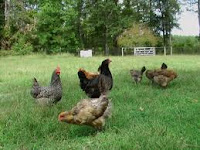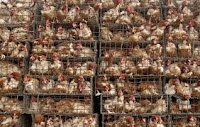.JPG) One evening in the Tennessee hills a good 15 years or so ago Kimberlie and Ralph Cole were sitting on the porch of their newly acquired farmhouse surveying their land - one hundred acres of pasture, scrub and trees; a strong wind was blowing in from the west and at that moment West Wind Farms was born.
One evening in the Tennessee hills a good 15 years or so ago Kimberlie and Ralph Cole were sitting on the porch of their newly acquired farmhouse surveying their land - one hundred acres of pasture, scrub and trees; a strong wind was blowing in from the west and at that moment West Wind Farms was born. Exciting as this was, trepidation was not far behind. Both Kimberlie and Ralph had 'day jobs' as environmental research scientists in the city of Oakville and here they were out in the boonies of TN about to embark on a life altering journey.
West Wind Farms is set just outside Deer Lodge TN and according to a historical description of the town "The climate is charming. The water is pure and soft [and]...The wild lands are covered with an indigenous grass on which, cattle, sheep or horses thrive and fatten".
 |
| Photo from West Wind Farms' website |
...Perfect farming conditions.
The prompt to buy the farm and land came from a realisation - that working to earn money to pay the bills and buy life's essentials seemed to be an inefficient way of living - it began to make more and more sense to cut out the middle man, as it were, and provide their own necessities. So...some land to grow vegetables and to graze livestock were what they needed, and this led them to cashing in their nest egg and buying the farm that has now become their homestead, their livelihood and their lifestyle.
Both the Coles maintained their jobs and spent a few gruelling years juggling jobs, farming and commuting, often getting by on only a couple of hours sleep. I am sure there were many moments when nature didn't cooperate, when sleep seemed like a far distant dream, when animals were sick and needy, when they were scraping the bottom of the financial barrel, when their fixer-upper farmhouse was not getting fixed up that they thought "what the heck were we thinking of..."
But hard-work, sheer determination and their vision kept them going.
They grew a few crops and vegetables to eat, raised chickens for meat and eggs, and kept a cow or two for milk. After a while they were producing more chickens than they could eat and began selling their chickens to neighbours and friends in the locale. It turned out that their chicken was really good and their small customer base just couldn't get enough. It seemed like they were rearing and producing quality food and perhaps could eventually make a living out of this!!
Their professions equip them to make use of the geology of the land and environmental resources, and it transpired that a wonderful geological nugget came with the land - the mineral rights to a natural gas source. What could be better for a couple of environmental scientists? So harnessing their natural gas and solar power, West Winds is now almost energy self-sufficient. I must admit for me it was a first, and a most impressive experience being taken on a farm tour by Kimberlie in their natural gas powered farm truck! The Coles are thrilled that they can make their sought after deliveries and trips to farmers markets without making a dent in their carbon footprints.
So to the animals - pigs, dairy cows, beef cattle, sheep and chickens - all pasture raised in the Tennessee hills.
West Wind Farms meat is available online, farm pick-up, Farmer's Markets in Tennessee and North Georgia, and 22 'host homes' - all the relevant information is available on West Wind Farms' website. We first came across WWF meat products last season at the Brookhaven Farmer's Market in Atlanta and we are happy that it will be available again this season when the market opens on May 5th.
As you will see from West Wind Farms' website although not yet available in 'mainstream' markets it is not too difficult to obtain their products and sample their delights.
Vital Awareness' visit to West Wind Farms was a rewarding experience: West Wind Farms is a wonderful model of what it means to practice humane and truly sustainable methods of farming, whilst maintaining an excellent quality of meat. ~ THE ACTIVIST
So to the animals - pigs, dairy cows, beef cattle, sheep and chickens - all pasture raised in the Tennessee hills.
What at first seemed a daunting amount of land for the Coles to tend and care for is today simply insufficient for their needs and they have acquired extra pasture over the years. Some of which they have purchased, some they rent, and the remainder is on loan from the generosity of neighbours who allow them to share parcels of their land for pasturing their animals. And today the hogs have their own 100 acre wood for foraging and routing.
As a testament to their commitment, efficiency, and responsible use of land and resources the Coles are able to keep a steady supply of meat flowing into markets in and around Tennessee. From what I understand the farm is ready to expand into larger markets but is not being given the opportunity - I hope that opportunity comes knocking soon!
West Wind produces excellent quality pork, beef, lamb, chicken, and milk. Currently there are 26 Jersey dairy cows on their farm, and as well as being the biggest producer of raw milk in the state (through the 'pet' milk and the cow share laws) WWF is also a producer of quality A2 milk, and its amazing how many wholesome pints one can get out of a small pasture raised herd. There is controversy around the healthy and unhealthy aspects of milk. Milk in its raw state contains the most usable form of protein and minerals which have not been altered or destroyed by the intense heat of pasteurisation - the law varies from state to state as to the permissible retail sale of raw milk (this Raw Milk 'Map' was last updated in 2010 and I am assuming is still current). But to add to that the talk now seems to be about A1 versus A2 milk!! In a nutshell, A2 milk is considered better for one's health than A1. The former comes from the older breeds such as Guernsey and Jersey cows, the latter from Holsteins - unfortunately Holstein milk is the most prolific in the U.S. because Holstein's are big milk producers: in other words you get more milk per pound from a Holstein than a Jersey. So if you aren't able to get raw milk or the thought of drinking unpasteurized milk scares you then I guess you should make sure the milk you drink is the A2 variety. Guernsey cow's milk is the highest in A2 proteins, and Jerseys come in next. There doesn't seem to be a lot of talk of it in the U.S. but check out UK and Australian websites if you want more information, or read my up-coming Dairy Blog.
I keep going back to this point...but from a personal standpoint, for me THE ACTIVIST, the jury is still out as to whether the dairy industry can really be considered humane in view of the fact that the calves are taken away from their mothers within days or hours of being born. This is a cyclical trauma for the cow and you can read about some of my concerns in my blog on Sweet Grass Dairy. I have been promising a dairy blog for a while now - honestly I will get to it, I just need to do more research (and a bit more soul searching, I guess). Ralph Cole explained that at West Wind Farms they have tried various methods of breaking the cow/calf bond and in their experience they felt that the kindest 'cut' was to remove the calf within a few hours, rather than leaving baby and mother together longer than 24 hours. But all that being said I believe that the dairy herds like those at Sweet Grass Dairy and West Wind Farms are treated as humanely as possible under the constraints of operating a viable dairy business.
WWF is a closed farm - this means that the animals are born on the farm and stay on the farm till they die - of old age for the breeders/milkers/layers or taken to slaughter for the meat livestock. Which brings me to another point - slaughtering. I have already touched on the inadequacies and often abusive conditions in USDA approved abattoirs in my blog on White Oak Pastures: The Stockman and The Vegan, and the Coles (I am assuming sharing concerns similar to mine) have, after careful research, been unable to find any processing facilities in Tennessee or neighbouring Georgia that meet their high standards for slaughtering and processing. Currently the chickens are taken to an Amish abattoir in Illinois a couple of states to the northwest, and the rest of the meat livestock to a facility in the neighbouring state of Missouri. This is a sad reflection on the state of the slaughtering facilities in the U.S., no matter how humanely a farmer raises his livestock the end is for the most part out of his or her control; and for the animals in many of the slaughter facilities in the U.S. it is often undignified and frequently cruel (and yes...if I can face it, a blog on the inadequacies of slaughter-houses will follow). West Wind Farms meat is available online, farm pick-up, Farmer's Markets in Tennessee and North Georgia, and 22 'host homes' - all the relevant information is available on West Wind Farms' website. We first came across WWF meat products last season at the Brookhaven Farmer's Market in Atlanta and we are happy that it will be available again this season when the market opens on May 5th.
As you will see from West Wind Farms' website although not yet available in 'mainstream' markets it is not too difficult to obtain their products and sample their delights.
Vital Awareness' visit to West Wind Farms was a rewarding experience: West Wind Farms is a wonderful model of what it means to practice humane and truly sustainable methods of farming, whilst maintaining an excellent quality of meat. ~ THE ACTIVIST

.JPG)
.JPG)









